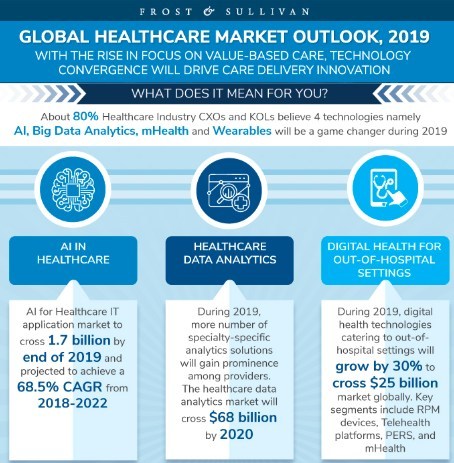Frost & Sullivan divulges top growth opportunities in Healthcare
29 January 2019 | News
The global healthcare market is likely to grow by 5.1 percent in 2019 and exceed $1.96 trillion in manufacturer revenues, the growth opportunities in the key regional markets will vary considerably.

By the end of 2019, up to 15 percent of the global healthcare spending is expected to be directed toward value-based care concepts. This will cause a surge in the number of risk-sharing contracts between providers and drug/device original equipment manufacturers (OEMs), driving business value for providers. While developed countries will adopt the more sophisticated outcome-based models, emerging markets will employ the best practices most suited to their local needs. Digital health technologies enabling out-of-hospital care and monitoring are forecast to grow by 30 percent to cross the $25 billion mark. As the lines between retail, IT and healthcare industries continue to blur, digital marketplace providers such as Amazon and Ali Health will make further headway in the home health space.
"In this highly digitized environment, artificial intelligence (AI) will permeate the life sciences ecosystem and its use in healthcare IT (HIT) is likely to cross $1.7 billion by the end of 2019. AI-powered IT tools that manage payers' and providers' business risks in clinical, operational, financial, and regulatory settings will especially find high uptake," said Kamaljit Behera, Industry Analyst, Transformational Health.
"Blockchain in healthcare is slowly starting to migrate from pilot proof of concept (PoC) to early commercial implementations. Companies such as Change Healthcare and Hashed Health will be frontrunners demonstrating initial ROIs across enterprise-level, B2B-focused initiatives such as health professional credentialing, medical billing management, and contract adjudication."
Frost & Sullivan's recent analysis, Global Healthcare Market Outlook, 2019, presents perspectives and forecasts for the pharmaceuticals and biotech, in-vitro diagnostics, medical technologies, medical imaging, and HIT sectors. The analysis also captures regional trends and identifies areas of opportunities.
"Access to affordable and quality care will be a key talking point during the upcoming 2019 elections in emerging markets such as Asia, Africa, and Central and Eastern Europe," noted Behera. "In fact, private drug and device companies will allot up to 10 percent of the R&D budget to localizing innovation to address the unique healthcare needs of developing regions."
While the global healthcare market is likely to grow by 5.1 percent in 2019 and exceed $1.96 trillion in manufacturer revenues, the growth opportunities in the key regional markets will vary considerably. The main trends in 2019 are presented below:
- United States: The priority is defining value across the healthcare continuum. Due to the high variance in healthcare costs, there will be pilot programs to reduce this variance to two standard deviations across all post-acute care modalities.
- United Kingdom (UK): The healthcare and life sciences sector will be a key topic of discussion during Brexit
- Europe (excluding the UK): Shifting economic, population, and behavior dynamics will lead to a rise in healthcare expenditure in many EU countries.
- Japan: This country is facing a formidable shortage of care workers as the aging population raises healthcare costs. During 2019, Japan's policy reforms will aim to reduce hospital length of stay with improvements in the quality of long-term care, especially through digitalization.
- Latin America: Most of the large to medium economies in Latin America promote universal health coverage. Concerns related to effective healthcare access will drive the adoption of new technologies.
- China: It is forecast to capture more than 20 percent of the total APAC healthcare revenue owing to aggressive policy making to support medical device and pharma markets.
- South Korea: It is expected to aggressively invest in developing a more robust clinical trial environment for medical devices and pharmaceuticals in 2019 to become a global clinical trial hub.
- Southeast Asia: The healthcare benefit cost provided by employee health programs is anticipated to increase by 10 percent to 15 percent across the ASEAN countries.












